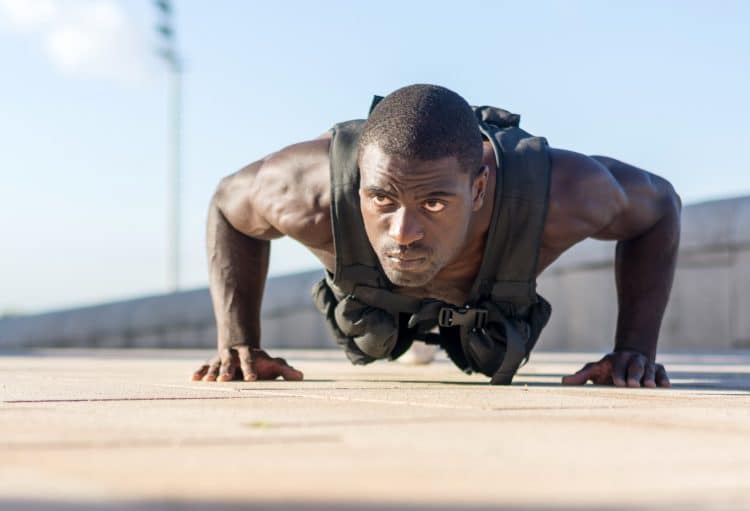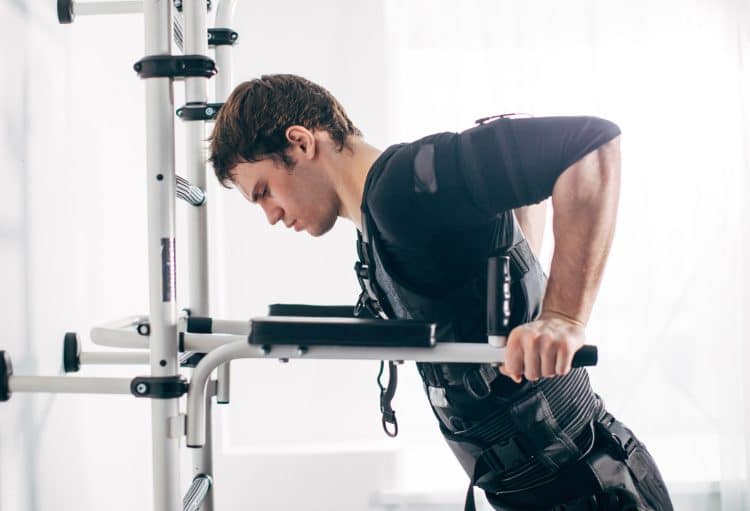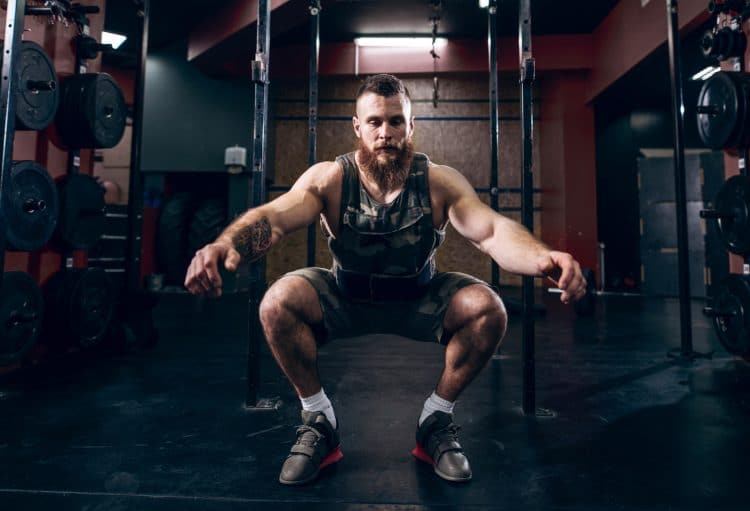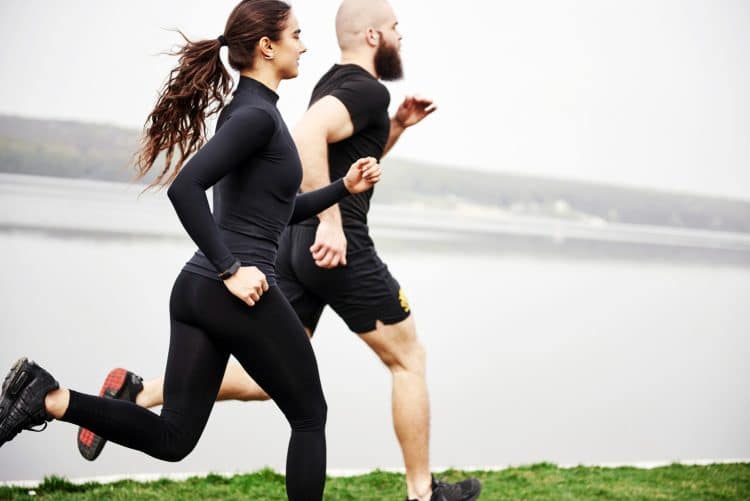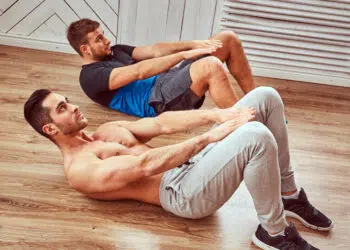Bodyweight training has several advantages — it is easy to learn, joint-friendly, and can be done anywhere at any time.
However, what makes bodyweight training so effective is also one of its main drawbacks — your body weight. As you get stronger, exercises like push-ups and pull-ups become less effective. The only way to make them more challenging is to do more reps, which can become boring and inefficient.
For this reason, many calisthenic practitioners start to gravitate toward more skillful exercises, like muscle-ups, front levers, and planches.
But you don’t need to start training like a gymnast just because you can do a lot of push-ups. As a seasoned personal trainer with over 30 years of experience, I’ve found that incorporating a weighted vest into bodyweight workouts is an excellent way to amplify the training challenge and effectiveness.
In this article, I reveal the 10 best weighted vest exercises and provide you with five of my favorite workouts.
Level Up Your Fitness: Join our 💪 strong community in Fitness Volt Newsletter. Get daily inspiration, expert-backed workouts, nutrition tips, the latest in strength sports, and the support you need to reach your goals. Subscribe for free! Recent Updates: On June 14, 2024, Fitness Volt’s Senior Editor, Vidur Saini (American Council on Exercise-CPT), updated the article and added actionable expert tips throughout the piece to improve the reader experience.
10 Best Weighted Vest Exercises
You can wear a weighted vest to make almost any bodyweight exercise easier. That said, here are 10 of my favorite weight vest calisthenic moves:
- Weighted Vest Push-Ups
- Weighted Vest Parallel Bar Dips
- Weight Vest Pull-Ups And Chin-Ups
- Weighted Vest Inverted Rows
- Weighted Vest Squats
- Weighted Vest Lunges
- Weighted Vest Bulgarian Split Squats
- Weighted Vest Planks
- Weighted Vest Rollouts
- Walking, Jogging, Running, And Sprinting
1. Weighted vest push-ups
| Sets & Reps | 3 x 8-12 (or to near failure) |
| Equipment Needed | Weighted Vest |
| Target Muscles | Pectoralis major, anterior deltoids, triceps brachii |
Are you looking for an exercise to rival the mighty bench press? Try weighted vest push-ups. Wearing a weighted vest will turn this muscular endurance exercise into a bonafide mass and strength builder.
Saini recommends a controlled tempo: three seconds down, one-second pause at the bottom, and one second up. This increases time under tension, stimulating greater muscle growth.
Pro Tip: Don’t underestimate the power of push-up variations. Adjusting your hand placement and tempo or adding a decline can significantly target different muscle fibers within the chest and triceps for more well-rounded development.
Options to try include:
- Regular push-ups
- Decline push-ups
- Deficit push-ups
- Diamond push-ups
- Ring push-ups
Read more about the power of push-ups here.
2. Weighted vest parallel bar dips
| Sets & Reps | 3 x 8-12 (or to near failure) |
| Equipment Needed | Weighted Vest, Parallel Bars |
| Target Muscles | Pectoralis major (sternal head), triceps brachii, anterior deltoids |
Long before the bench press was the world’s favorite chest exercise, parallel bar dips ruled supreme. Fans of bodyweight training often call dips “the upper body squat” because it’s such a productive exercise.
Dips work your chest, shoulders, and triceps and are one of the best exercises for bulking up your upper body. However, they can be hard on the joints, so take care not to descend too low if you have a history of shoulder pain.
“Consciously push your shoulder blades forward at the top of each rep,” says Saini. This activates your serratus anterior, improving stability and power output.
Pro Tip: Emphasize the slow, controlled descent to maximize muscle engagement and build strength throughout the full range of motion.
Options to try include:
- Gironda chest dips
- Triceps dips
- Paused dips (pause at the bottom of each rep for 2-3 seconds)
- Bench dips
- Straight bar dips
3. Weight vest pull-ups and chin-ups
| Sets & Reps | 3 x 8-12 (or to near failure) |
| Equipment Needed | Weighted Vest, Pull-Up Bar |
| Target Muscles | Latissimus dorsi, biceps brachii, trapezius, rhomboids |
Build your back and biceps without resorting to lat pulldowns by doing weight vest pull-ups and chin-ups. Pull-ups are done using a shoulder-width or wider overhand grip, while chin-ups use an underhand, narrower than shoulder-width grip. Weighted chin-ups are arguably the best bodyweight biceps builder.
Saini suggests engaging your lats by pulling your shoulder blades down and back before initiating each rep. This pre-tension enhances mind-muscle connection and maximizes lat involvement.
Pro Tip: Experiment with different grips (wide, close, neutral) and body angles to target various muscle groups within your back and biceps.
Options to try include:
- Paused pull-ups and chin-ups (pause at the top of each rep for 2-3 seconds)
- Slow tempo pull-ups and chin-ups
- Negative (eccentric) pull-ups and chin-ups
Read more about pull-ups and chin-ups here.
4. Weighted vest inverted rows
| Sets & Reps | 3 x 8-12 (or to near failure) |
| Equipment Needed | Weighted Vest, Smith Machine/Barbell, Suspension Trainer (optional) |
| Target Muscles | Latissimus dorsi, biceps brachii, trapezius, rhomboids |
Like pull-ups and chin-ups, inverted rows work your lats and biceps. However, the unique line of pull increases activation of the scapular retractors, i.e., the middle trapezius and rhomboids.
This means that inverted rows are an excellent postural exercise that will help build upper back thickness. They’re also a little easier than weighted pull-ups and chin-ups, so they are a good option as a secondary back exercise.
Pro Tip: Focus on squeezing your shoulder blades together at the top of each rep to activate your mid-back muscles and reinforce proper posture.
Options to try include:
- Overhand inverted row
- Underhand inverted row
- Ring row
- Feet elevated inverted row
- Paused inverted row (pause at the top of each rep for 2-3 seconds)
Read more about inverted rows, AKA Australian pull-ups, in this guide.
5. Weighted vest squats
| Sets & Reps | 3 x 8-12 |
| Equipment Needed | Weighted Vest |
| Target Muscles | Quadriceps, hamstrings, gluteus maximus |
Squats are the king of leg exercises. Whether you want to build bigger legs, get stronger, or improve your athletic performance, squats will help. But, as a bodyweight leg exercise, bodyweight squats probably aren’t all that challenging unless you do 50-100 reps per set.
The weighted vest squat is a full-body movement that demands core engagement and stability. Wearing a weighted vest will help reduce the reps and make your workouts more time-efficient.
Pro Tip: Hold the bottom position of the squat for 1-2 seconds to eliminate momentum, achieve greater muscle recruitment, and improve control.
Options to try include:
- Squats to parallel
- Squats below parallel
- Wide stance squats
- Paused squats
- Squat jumps
- Sissy squats
- Cyclist squats (heels elevated)
Discover even more squat variations here.
6. Weighted vest lunges
| Sets & Reps | 3 x 8-12 per leg |
| Equipment Needed | Weighted Vest |
| Target Muscles | Quadriceps, hamstrings, gluteus maximus |
Even with a weighted vest, you may still find squats a little too easy to be productive. Lunges place more weight on your front leg, so you can use them to overload your muscles better. There is a 60/40 front-to-back weight distribution during lunges.
Since lunges are a unilateral exercise, they are excellent for identifying and fixing strength and muscle balances and improving your balance, mobility, and coordination, says Saini. Weighted vest lunges are quite challenging, so resist the temptation to go too heavy too soon.
Pro Tip: After each set, perform a hip flexor stretch (e.g., kneeling lunge stretch). Tight hip flexors can limit the range of motion and hinder glute activation.
Options to try include:
- Forward lunges
- Backward lunges
- Walking lunges
- Deficit lunges
- Jumping lunges
- Step-through lunges
Read more about these and more lunge variations here.
7. Weighted vest Bulgarian split squats
| Sets & Reps | 3 x 8-12 per leg |
| Equipment Needed | Weighted Vest, Bench |
| Target Muscles | Quadriceps, hamstrings, gluteus maximus |
While no one really knows how this exercise is connected to Bulgaria, there is no denying that it never fails to deliver an effective leg workout. While similar to lunges, the Bulgarian or rear foot elevated split squat involves a larger range of motion and requires more balance, increasing muscle engagement.
The Bulgarian split squat is a quadriceps-dominant movement, but it also engages the hamstrings and glutes to a significant degree, says Saini.
Pro Tip: As you lower yourself, keep your front shin as vertical as possible to reduce knee stress and emphasize quadriceps engagement.
Options to try include:
- Split squats (both feet on the floor)
- Deficit Bulgarian split squats (front foot elevated)
- Bulgarian split squat jumps
- Paused Bulgarian split squats
- Bulgarian split squats 21s
Discover more about Bulgarian split squats here.
Level Up Your Fitness: Join our 💪 strong community in Fitness Volt Newsletter. Get daily inspiration, expert-backed workouts, nutrition tips, the latest in strength sports, and the support you need to reach your goals. Subscribe for free!
8. Weighted vest planks
| Sets & Reps | 3 x 30-60 seconds (or to failure) |
| Equipment Needed | Weighted Vest |
| Target Muscles | Core (rectus abdominis, transverse abdominis, obliques) |
The core is the collective term for the muscles of your midsection, including the rectus abdominis at the front, the obliques at the side, and the deep, transverse abdominis muscle. Planks are a great core exercise, but if you can do it for 60 seconds or more, it may not be the best use of your training time.
Saini prescribes advanced exercisers to use a high plank (arms fully extended) position for greater core engagement.
Pro Tip: Maintain a slight posterior pelvic tilt (tuck your tailbone under). This engages your core more effectively and protects your lower back.
Options to try include:
- Plank on elbows
- Plank in the push-up position
- Plank with feet elevated
- Plank with elbows on a stability ball
- Plank with alternating leg raise
- Body saw
- Side plank
9. Weighted vest rollouts
| Sets & Reps | 3 x 8-12 (or to failure) |
| Equipment Needed | Weighted Vest, Ab Wheel |
| Target Muscles | Core (rectus abdominis, transverse abdominis, obliques) |
Rollouts are a sort of cross between planks and push-ups. They involve changing the position of your hips and shoulders as you work hard to stabilize your spine with your core. Bodyweight rollouts are challenging, and weighted vest rollouts are considerably more so. If you want an iron-clad core, this is the exercise to do it.
The ab rollout is one of the most effective core exercises you can do, as it targets both the rectus abdominis (six-pack muscles) and the deeper core muscles responsible for stability and spine health, says Saini.
Pro Tip: Focus on a slow and controlled return from the extended position to maximize abdominal muscle activation.
Options to try include:
- Kneeling rollout
- Standing rollout
- Paused rollout
- Barbell rollout
- Stability ball rollout
- Suspension trainer rollout
Discover more about rollouts here.
10. Walking, jogging, running, and sprinting
| Sets & Reps | Varied based on fitness level and goals. 20-40 minutes of steady-state cardio or interval training. |
| Equipment Needed | None, or Treadmill for controlled environment. |
| Target Muscles | Primarily cardiovascular system, but also engages leg muscles |
While wearing a weighted vest is an excellent way to make bodyweight strength training exercises more demanding, you can also wear one for cardio. For example, walking, running, sprinting, jumping rope, etc., in a weighted vest will force your muscles to work harder and increase oxygen demand. As such, you’ll burn more calories per workout.
However, because of the increased impact, you should start light and gradually increase the weight of your vest. Back off if you feel any knee, hip, or back pain.
You can use a weighted vest for high-intensity interval training and low-intensity steady-state workouts.
While running is primarily a cardiovascular exercise, it also builds lower body strength and endurance, adds Saini.
Pro Tip: Incorporate hills, trails, or sand into your runs. This challenges your muscles differently, improves balance and stability, and enhances overall running performance.
5 Best Weighted Vest Workouts
While there is nothing wrong with just wearing a weight vest for your usual bodyweight workout, you’ll probably get better results if you follow a more structured plan. Here are five of my favorite weighted vest workouts.
Also, more weight means more impact, so take care with exercises like running, squat jumps, jump rope, etc. Avoid these activities if you have a history of foot, ankle, knee, hip, or back pain.
Warm up before and cool down after every workout. Don’t wear your weight vest for your warm-up and cooldown. Instead, put it on when you are ready to start your workout. Do a few reps without your weight vest to get used to the exercises you’re about to perform.
1. Walk
Walking while wearing a weight vest turns what is usually a easy activity into something much more challenging, especially if you pick up the pace or head uphill. Walking in a weight vest will strengthen your legs, build fitness, and burn calories.
How far should you walk? Not as far as you think! Start off with a mile or two and increase from there.
2. Heavy Cindy
Cindy is a popular CrossFit workout that involves doing as many rounds as possible in 20 minutes of:
- 5 pull-ups
- 10 push-ups
- 15 air squats
It works all your major muscles in a workout that’s perfect for time-pressed home exercisers.
Cindy is more challenging in a weighted vest, so reducing the reps and the overall duration is a good idea.
So, for this workout, do as many laps as possible in ten minutes of:
- 3 pull-ups
- 6 push-ups
- 9 air squats
3. Weighted vest leg killer
You can build mass and strengthen your legs with this simple yet effective body weight and weight vest leg workout.
Do three sets of the following exercises, aiming for 10-15 reps per set. Rest 60 seconds between sets.
- Squat jumps
- Bulgarian split squats
- Box squats
- Walking lunges
- Single-leg calf raises
4. Cardio confusion
This weight vest workout will build fitness, burn calories, and strengthen your legs. After your warm-up, head out (or use a treadmill) and do the following:
- Walk — two minutes
- Jog — one minute
- Run — one minute
- Sprint — one minute
Repeat this sequence four times to total 20 minutes, or six times for 30 minutes.
5. P-P-L workout
P-P-L stands for push, pull, and legs. This workout trains all your major muscles with six compound exercises. Those six exercises are split into two mini circuits, so, besides building muscle strength and size, you’ll also get a short but intense cardio workout.
Do three laps of the following:
- Deficit push-ups: 8-12
- Inverted ring rows: 8-12
- Bulgarian split squats: 8-12 per leg
Rest a moment, and then do the laps of these three exercises:
- Dips: 5-8
- Chin-ups: 5-8
- Squat jumps: 5-8
What to Look for In A Weighted Vest
If you’ve already got a weighted vest, you can skip this section. But, if you are thinking about buying one, these are the things you need to consider:
Related: 10 Best Weighted Vests to Up Your Training Intensity and 8 Best Women’s Weighted Vests Reviewed
1. Maximum weight
Weighted vests come in various maximum weight capacities — from 10 pounds to 50 pounds or more. Most are also adjustable. It makes sense to buy a weighted vest with a high load capacity so you can continue adding weight and using it for many years, even if you get super-strong.
In contrast, if you buy one with a low weight capacity, you may find that you out-grow it in a few months and end up needing to buy another.
So, choose a weight vest that’ll hold plenty of weight. That way you can continue increasing the load as you get stronger.
2. Size, fit, and adjustability
The last thing you want is for your weight vest to shift around while you work out. Nobody wants that kind of distraction! So, if possible, try your weight vest before buying it to ensure that it fits properly. If this is not possible, look for models with plenty of options for adjustability, i.e., elastic compression straps, etc.
Also, consider the length of your weight vest. Short vests leave your abdomen exposed, making them cooler and easier to move around in. However, that also means all the weight is concentrated on your chest and upper back. Longer vests spread the load over a greater surface area but tend to be more inhibiting.
Ultimately, your vest should be comfortable and not interfere with your workout.
3. Construction
A good weighted vest should be built to last. Look for things like taped and reinforced seams, hardwearing materials like Kevlar and CORDURA, and strong plastic buckles. Cheaper vests are made from lightweight materials like polyester and nylon, which are not as tough and are more likely to split or tear.
4. Type of weights
The weights in weighted vests vary from small metal ingots to packets of iron filings or sand to metal or ceramic plates. Each one will affect the fit and feel of your vest.
Metal ingots are compact and rigid and give your vest a slimmer profile. Iron filings are cheap but bulky and may reduce your mobility. Metal and ceramic plates are expensive but are molded to the shape of your body, making this kind of vest very streamlined and less obtrusive. However, they’re also less adjustable.
Consider what you want from your weighted vest and choose the type of weight that best suits your needs and budget.
Also, consider the weight denominations of your vest. Ideally, you should be able to adjust the load in small increments, that is, 1-2 pounds at a time.
Note: As a side note on weights, take care not to try and use too much weight too soon. Start with around 5-10 percent of your body weight and increase gradually from there, e.g., 1-2 additional pounds per week. Diving straight into push-ups and pull-ups with a 50-pound weight vest is a recipe for injury!
5. Cost
Weighted vests can be expensive, and more dollars doesn’t always mean a better product. Set your budget, and then look for products within your price range. You could also get a used weighted vest if buying new is not affordable.
Finally, consider alternatives to weight vests, such as a backpack loaded with books. While not as comfortable or versatile as a good weighted vest, you can use a low-tech approach like this to make many bodyweight exercises easier without spending money on a weighted vest.
Wrapping Up
Basic calisthenic exercises like push-ups and pull-ups are a great way to train. You can do most of them almost anywhere and anytime, and usually for free!
But, if you are serious about pushing your physical limits, your own body weight may not be enough resistance to challenge and develop your muscles.
After all, if you can crank out dozens (or even hundreds) of reps, whatever you are doing will probably not trigger much of an adaptive response.
A weighted vest will allow you to add to your body weight and make your calisthenic workouts more demanding.
The best weighted vests are adjustable and comfortable, making almost every bodyweight exercise more effective. Just remember to start light and increase gradually. Too much weight too soon could lead to injuries.

